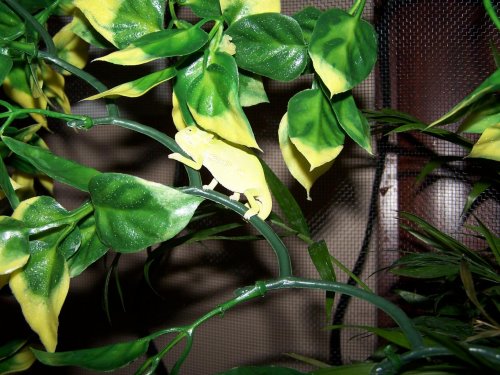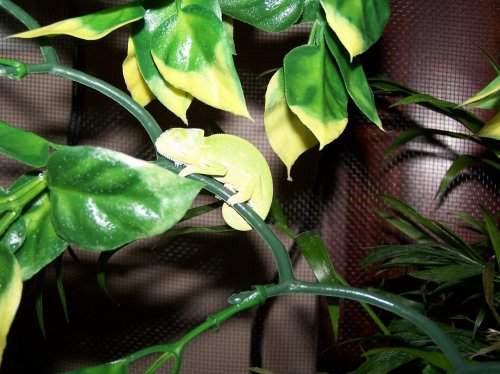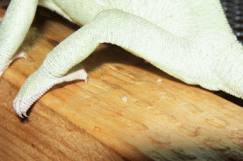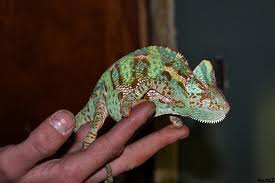Hello, All!
I’m a proud new owner of what I think is a 2-3 month old Veiled Cham. I say that because I just brought it home today and the kids who work at the local pet store (which is located in a VERY small town) were not sure of much of anything other than it’s a Veiled. They had three in the lot, and I chose the one that seemed larger and more active.
I’m not new to reptiles at all, just chameleons. I currently have a very nice Leopard Gecko named Chester who’s been with us for going on a year now (super friendly, and super hungry ALL the time)- and I’ve had a newt and anole here and there over the course of my life. In any case, I got really interested in lizards while I was in Iraq during my last tour back in 2007. Not really sure what they were, but they would come out at night and rip moths out of mid air around our light fixtures. I digress.
The reason I’m here (aside from the GREAT information) is because I have what must seem like newbie questions, but before I get to the Q’s, let me tell you what I have so far:
One green chameleon- no idea of sex, and approximately 3 to 3 ½” long from nose to tail. It’s in the final stages of a shed and still has dead skin on his head.
One Cage that’s 18”L X 12”W X 20”H and it’s made by Zilla
One 13w Repti Glo 5.0 UVB with a metal bulb holder.
One 60w regular old light bulb for basking, again with a metal bulb holder.
I have a can of Repti Calcium without D3
A small Palm plant and some pretty long vine plastics that create the zig zag effect from basking area to the lowest point in the cage (I plan to add two more spider plants tomorrow).
I’m using a generic spray mister 3X daily for about 2 minutes until everything starts dripping.
Before I turned it’s lights off for the night, the temp was about 90 degrees and the humidity was sitting at about 60%
I have not fed it tonight, but plan to do so tomorrow morning.
Here are my questions:
1. From the pictures, can anyone tell me the age and/or sex of the beastie?
2. When I feed it tomorrow, how many SMALL crickets do I offer, and do I use any of the calcium?
3. Other than a pricey dripper, what else can I used that will drip water rather slowly for an hour or so twice a day? I plan to have the drip tube splash on the plastic plant and then drip down into the real potted plants.
4. Back to feeding, do I try to get the crickets in the leaves, put them on the base of the cage or try to offer from a small opaque cup?
5. What’s the best gut load for these crickets? I have apples, potatoes, and dog food on hand.
6. Do I feed it every day, once a day in the AM, or a couple times a day depending on how many it eats in the AM?
7. If this is a female- will she lay eggs without being in contact with a male? If so, how do I prepare for that wonder?
Okay, those are my questions. I hope the experienced members of the forum can help me.
Thanks in advance for any answers and advice- I need it. And I’m quite sure I’ll have more down the road. This is an excellent forum!
Regards,
Will
I’m a proud new owner of what I think is a 2-3 month old Veiled Cham. I say that because I just brought it home today and the kids who work at the local pet store (which is located in a VERY small town) were not sure of much of anything other than it’s a Veiled. They had three in the lot, and I chose the one that seemed larger and more active.
I’m not new to reptiles at all, just chameleons. I currently have a very nice Leopard Gecko named Chester who’s been with us for going on a year now (super friendly, and super hungry ALL the time)- and I’ve had a newt and anole here and there over the course of my life. In any case, I got really interested in lizards while I was in Iraq during my last tour back in 2007. Not really sure what they were, but they would come out at night and rip moths out of mid air around our light fixtures. I digress.
The reason I’m here (aside from the GREAT information) is because I have what must seem like newbie questions, but before I get to the Q’s, let me tell you what I have so far:
One green chameleon- no idea of sex, and approximately 3 to 3 ½” long from nose to tail. It’s in the final stages of a shed and still has dead skin on his head.
One Cage that’s 18”L X 12”W X 20”H and it’s made by Zilla
One 13w Repti Glo 5.0 UVB with a metal bulb holder.
One 60w regular old light bulb for basking, again with a metal bulb holder.
I have a can of Repti Calcium without D3
A small Palm plant and some pretty long vine plastics that create the zig zag effect from basking area to the lowest point in the cage (I plan to add two more spider plants tomorrow).
I’m using a generic spray mister 3X daily for about 2 minutes until everything starts dripping.
Before I turned it’s lights off for the night, the temp was about 90 degrees and the humidity was sitting at about 60%
I have not fed it tonight, but plan to do so tomorrow morning.
Here are my questions:
1. From the pictures, can anyone tell me the age and/or sex of the beastie?
2. When I feed it tomorrow, how many SMALL crickets do I offer, and do I use any of the calcium?
3. Other than a pricey dripper, what else can I used that will drip water rather slowly for an hour or so twice a day? I plan to have the drip tube splash on the plastic plant and then drip down into the real potted plants.
4. Back to feeding, do I try to get the crickets in the leaves, put them on the base of the cage or try to offer from a small opaque cup?
5. What’s the best gut load for these crickets? I have apples, potatoes, and dog food on hand.
6. Do I feed it every day, once a day in the AM, or a couple times a day depending on how many it eats in the AM?
7. If this is a female- will she lay eggs without being in contact with a male? If so, how do I prepare for that wonder?
Okay, those are my questions. I hope the experienced members of the forum can help me.
Thanks in advance for any answers and advice- I need it. And I’m quite sure I’ll have more down the road. This is an excellent forum!
Regards,
Will







